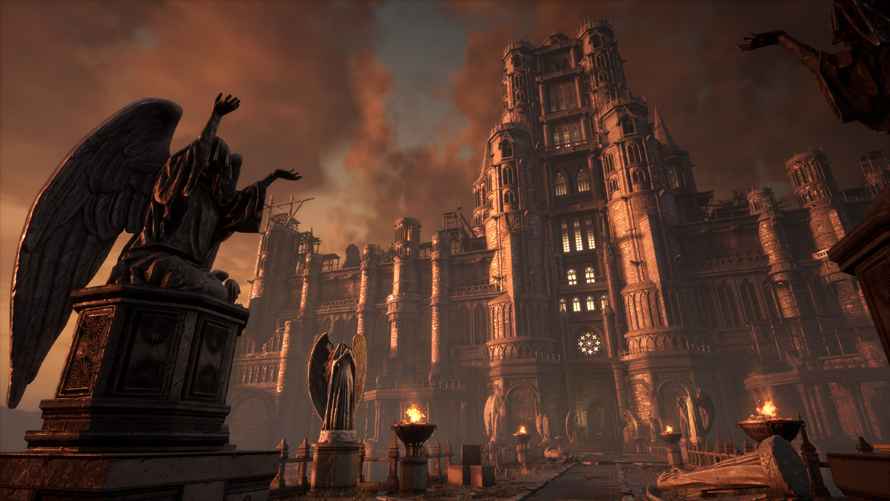Lies of P Review
I love it when a musical artist remixes a familiar song in new and unexpected ways. You know, like playing Green Day’s American Idiot as a guitar folk ballad. Sometimes these things work, sometimes not so much. When they hit, though, they can reveal hidden aspects or fresh perspectives. I thought of that while playing Lies of P. It’s an unapologetically Soulslike action game. But not just that. It’s also an unapologetic love letter to FromSoftware, and players will recognize ideas from all the Souls games, Elden Ring, Sekiro and, especially, Bloodborne. Still, Lies of P is more than a cheesy cover band ripping off someone’s hard-earned style. It has its own identity. More surprising, there are small moments when it surpasses its inspiration.
From Niche to Mainstream
Over the past ten years FromSoftware has gone from being a niche developer with a series of hardcore fantasy games to sitting at the top of the heap when it comes to consistency and polished design. The Dark Souls franchise spawned an entire sub-genre of action RPGs, too many clones and ripoffs to count. Sadly, most of the wannabe’s focus on the wrong aspect of FromSoft’s philosophy. Some developers just make their game ridiculously difficult, add a health and stamina bar and call it done.
One of Lies of P’s strengths is that it understands the real FromSoftware secret sauce, which is that their games start with respecting the player’s intelligence, time and ability to problem solve. There are few challenges in the Soulsborne games that require brute force alone, but the smart use of the tools available, skills that can be mastered, or even ways to avoid a situation altogether. If a player is stuck and frustrated, they are almost always missing something. Those concepts are translated into mechanics, like stamina management, parrying and dodging, and appropriate weapon selection. So too in Lies of P. It nails the loop of failure and progression.
Wait…Whaaat?
If you’re like me, you did a double take at the thought of Pinocchio as the subject of a moody gothic action game. Like most so-called children’s stories from the 19th century, Pinocchio is actually a pretty dark adult novel tale, miles away from Disney’s benign cartoon. Lies of P captures the uneasy tone of the original story. Beyond that, there are skeletal remains of the narrative and some important characters, like Geppetto, Gemini (Jiminy Cricket) the donkey, dog, and others.
Visually inspired by the European Belle Époque era of the late 19th century, Lies of P is set in the city of Krat, a progressive metropolis where the inventor Geppetto has filled the town with animated puppets, futuristic elevated trains, and utopian ideas. As is always the case, a maddening affliction spreads amongst the puppets, turning them on the human population. You play as Pinocchio, the puppet with dreams of becoming human, and literally everyone is your enemy.
If Bloodborne and BioShock had a baby, it would look and sound a lot like Lies of P, with a bit of Steel Rising’s DNA mixed in. This is a gear-and-steampunk world of mechanical, maniacal circus ringmasters, huge clockwork spiders, and coal-fired, rolling machines of death. In the way Bloodborne pivots from werewolves to Lovecraftian horror, Lies of P transitions from machines to more organic monstrosities that bellow like the best screamo metal singers. Overall, Lies of P’s world building is excellent, with lore and story hidden throughout.

Borrowed from the Best
Lies of P’s level design borrows heavily from Dark Souls and Bloodborne. This means there are some Yharnam-eque sections, cathedrals and castles that wouldn’t look out of place in Dark Souls 3 or Elden Ring, and bits that echo Blighttown, just for starters. One memorable, rage-quit inducing level gleefully pulls together the most frustrating mechanical elements of Anor Londo’s cathedral rafters and archers, embedding them in a version of Sen’s Fortress sitting on top of a toxic swamp. What’s that? You want me to run an endless gauntlet filled with enemies, jumping puzzles, limited healing, and a mini-boss at the end? Sure thing.
The art design of Lies of P’s levels is often explicitly derivative. That’s not to say they don’t look great. They do, with a ton of detail and excellent, evocative lighting. There are more than a few places where Lies of P looks much better than nearly anything in the FromSoft catalogue, especially the older games. Although they look amazing, the levels are relatively compact. They have the requisite secret areas, side paths, and shortcuts, but they’re maybe the least remarkable aspect of the game. And while there are save/fast travel points (called Stargazers) along the way, the game is essentially one long path from start to finish. Lies of P has its version of Roundtable Hold or Firelink Shrine, in the form of the stately Krat Hotel.
The Meat of the Puppets
If level design and art style stick very close to their FromSoft inspirations, Lies of P does diverge a bit in the areas of combat mechanics and gameplay. In this aspect — and in a few quality-of-life features — FromSoftware could pick up an idea or two. However, combat will still feel comfortably familiar to Souls veterans.
Pinocchio has a bladed weapon in his right hand and a prosthetic arm on the left. Throughout the course of the game, the player unlocks a wide range of weapons that all fall into three basic groups: fast and light, slow and heavy, or balanced. Some of the weapons are near-useless novelties but the majority are fun to experiment with. Like most RPGs, there is a weapon to suit everyone’s play style.
What sets Lies of P apart is that a weapon’s handle is a separate component, and the player can mix and match handles and blades. For example, you might choose the handle from a powerful greatsword, but the business end of an electrically charged club. Lies of P doesn’t have near the weapon catalog of a game like Dark Souls 3 or Elden Ring, but the ability to combine parts adds a huge amount of potential. Both the blade and handle carry something called Fable Arts (obviously, similar to Weapon Arts) and this allows for some very useful hybrids.
The mechanical left arm can be outfitted with a variety of unlockable special abilities and spell-like elemental effects. While performing just about every upgrade costs Ergo (the game’s soul-like currency), the needed components are found by exploration, combat, and purchased at vendors. As in most FromSoft games, leveling up means a trip back to the home base hotel.
Hammer Meets the Head
Overall, combat feels great and it flows very similarly to the best moments in FromSoft’s games. A few of the animations feel a little stiff now that Elden Ring has trained us, and not being able climb feels old-school and limiting. Lies of P has at least two quality-of-life features that everyone will appreciate. First, when you die to a boss, your dropped Ergo is waiting outside the fog gate. Second, your Ergo counter turns to blue when you have enough to level up. It also shows how much you lost when you died.
Lies of P has an excellent selection of enemies, from low-level trash mobs to a broad selection of mini-bosses and chapter-ending boss battles. More than a few bosses demand a specific technique like perfect blocks, backstabs, or elemental attacks. While there is no multiplayer, Lies of P includes optional NPC summons for the main bosses. The NPC is mostly useful for distraction or tanking. It never feels like it can win the fight for you.

At their best — which is to say, most of the time — FromSoftware games use increasing mastery and a steady drip of difficult encounters in place of a difficulty setting. For many players, besting a Dark Souls boss after multiple attempts or simply surviving the gauntlet of a level is a unique dopamine rush.
Lies of P nails this, too, maybe better than any non-FromSoft game I’ve ever played. Be warned, though: around 20 hours in there’s a difficulty spike. It’s not well supported by access to upgrade materials or new weapons. After 20+ hours of elation, Lies of P turns into a bit of a slog. It recovers, but that section just reminded me just how good the pace and challenge balance had been.
Animatronic Stiffness
As articulate as combat animations are in Lies of P, the game’s NPCs are disappointingly static. To be fair, it’s a complaint often also aimed at Dark Souls or Elden Ring NPCs. Lies of P’s audio is all good news. Environments, weapon sounds, and special effects are excellent and the musical score is outstanding. It hits both lovely moments of melancholy and thrilling orchestral accompaniments to boss battles. It’s the equal of anything in Dark Souls or Elden Ring, both known for great music.
FromSoftware’s games are known for their longevity. This is in part due to the immense number of ways to craft a character, the challenge of new game plus runs, and compelling multiplayer modes. This might be the one area in which Lies of P can’t help but fall short. You can’t do much in the way of customizing a character and clothing choices don’t impact stats at all. The levels are short enough that, by the time you’ve run through them 3-4 times with new builds, it starts to feel a bit overfamiliar.
On a PC with middling specs, Lies of P ran at a rock solid 60 fps in 4K. There was some pop in, especially as scenes were loading. I encountered a few minor bugs, but on the whole the technical performance was surprisingly good.

Familiar, Fresh and Fantastic
Calling Lies of P derivative is both obvious and misses the point. It’s is a love letter to FromSoftware, but one that quite often matches or even exceeds its inspiration. Lies of P doesn’t quite attain the elegance of Dark Souls, Elden Ring, or Bloodborne’s best level designs, but its art, graphics, and combat are possibly the best of any Soulslike not developed by Miyazaki and company. Lies of P is addictive, challenging, and rewarding, and a must-play for fans of action RPGs.
***PC code provided by the publisher for review***
The Good
- Fantastic art and sound
- Challenging and fun
- Familiar but fresh combat
- Great bosses
The Bad
- Some frustrating difficulty spikes
- Dodge roll timing takes practice
- Level design is simplistic
- Questionable longevity

